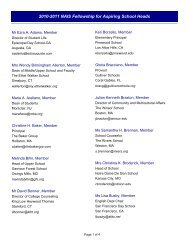History of NAIS from the Nineties to the New Millennium
History of NAIS from the Nineties to the New Millennium
History of NAIS from the Nineties to the New Millennium
You also want an ePaper? Increase the reach of your titles
YUMPU automatically turns print PDFs into web optimized ePapers that Google loves.
• To recognize that this society continues <strong>to</strong> honor teachers <strong>to</strong> a limited extent but <strong>to</strong>o<br />
<strong>of</strong>ten with misunderstanding and even disdain.<br />
• To meet head-on public misconceptions and criticisms <strong>of</strong> independent education.<br />
• To become more aware <strong>of</strong> demographic and economic fac<strong>to</strong>rs and <strong>the</strong> decline <strong>of</strong> our<br />
traditional sources <strong>of</strong> students.<br />
• To preserve our independence.<br />
• To create an ever stronger ethical context for teaching and learning in our schools.<br />
As if John’s challenges were not sufficiently demanding, <strong>the</strong> membership clearly called<br />
for greater efforts in several areas:<br />
• To embark on a concerted effort <strong>to</strong> inform <strong>the</strong> public about choice in education and <strong>to</strong><br />
create marketing initiatives.<br />
• To identify <strong>the</strong> most efficacious ways <strong>to</strong> improve public relations.<br />
• . To mount a renewed effort on access and affordability.<br />
• . To emphasize <strong>the</strong> <strong>the</strong>mes <strong>of</strong> equity and justice and <strong>to</strong> explore <strong>the</strong> multiple<br />
definitions <strong>of</strong> diversity.<br />
• . To broaden <strong>the</strong> scope and utility <strong>of</strong> <strong>NAIS</strong> statistics.<br />
• . To expand <strong>NAIS</strong> legal services in partnership with <strong>the</strong> state and regional<br />
associations.<br />
• . To explore ways <strong>to</strong> improve and streng<strong>the</strong>n accreditation.<br />
…and on and on….<br />
THE TRANSITION<br />
The <strong>NAIS</strong> board in 1992 was a living example <strong>of</strong> diversity in independent education; <strong>of</strong><br />
<strong>the</strong> 24 direc<strong>to</strong>rs, <strong>the</strong>re were six people <strong>of</strong> color, and <strong>the</strong>re were 10 women and 14 men.<br />
The board enthusiastically supported both <strong>the</strong> expansion <strong>of</strong> <strong>the</strong> staff, commensurate with<br />
<strong>the</strong> expanding agenda, and <strong>the</strong> commitment <strong>to</strong> bring true diversity <strong>to</strong> <strong>the</strong> staff; by <strong>the</strong><br />
mid-90s, firmly relocated in Washing<strong>to</strong>n, <strong>the</strong> staff was 40 percent people <strong>of</strong> color. As a<br />
staff, we made a policy decision: in every personnel search, <strong>the</strong>re would be at least one<br />
person <strong>of</strong> color. Word got around Washing<strong>to</strong>n, and did we ever attract <strong>to</strong>p candidates.<br />
The board also <strong>to</strong>ok a strong stand on parental choice <strong>to</strong> ringing endorsements by <strong>the</strong><br />
schools and associations. A unanimous board vote affirmed <strong>the</strong> intrinsic belief that




